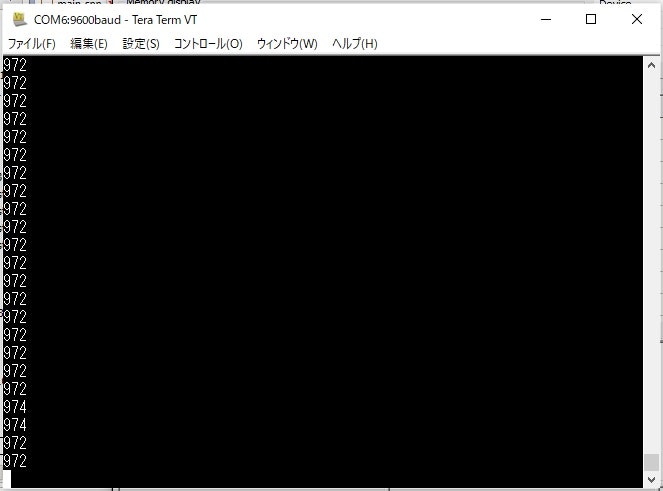x mbed2のリビジョン143
目的
基板作成が落ち着いたから
内部タイマーを使いusでオン時間で周波数を測る。
ディティが50対50じゃないと測れない。
シリアルに出力する。
レジスター直読み込みで高速化した。
x t.start()は、pwmの測定で利用されている
だいたい1khzを入力した
りろいろ改良 特にpwm測定
# include "mbed.h"
//10の割り算 0から1028までは、正しい。主に0から999
# define DVI10(n) ((n*205)>>11)
//1000の割り算 だいたい正しい
# define DVI1000(n) ((n>>10)+(((n>>10)*32)>>10))
# define HIGH 1
DigitalIn in1(PA_1);
DigitalOut led1(PA_4); //debug
RawSerial pc(PA_2, PA_3); //010 tx, rx
//タイマーの設定
Timer t;
//in1のオン時間をusで測る 今のところ引数は、無効
int pulseIn(int pin1,int pu1,int timeout1)
{
t.reset();
//while(in1 != 0) {}
loop_ins:
// 1234567890123456
if ( (GPIOA->IDR) & 0b0000000000000010 ) { goto loop_ins;}
//while(in1 == 0) {}
loop_s1:
// 1234567890123456
if ( (~(GPIOA->IDR)) & 0b0000000000000010 ) { goto loop_s1;}
//led1 = 1;//debug
int sd = t.read_us();
//while(in1 != 0) {}
loop_in1:
// 1234567890123456
if ( (GPIOA->IDR) & 0b0000000000000010 ) { goto loop_in1;}
//led1 = 0;//debug
return(t.read_us()-sd);
}//pulseIn
int main() {
t.start();
int pwmco2;
int hz;
while(1){
//PWMでデータ取得
pwmco2=pulseIn(7 ,HIGH,2000000);
// printf("The time taken was %d seconds\r\n", pwmco2 );
// printf("The time taken was %d seconds\r\n", DVI1000(pwmco2) );
pwmco2=pwmco2*2;
if(pwmco2==0){pwmco2=1;}
hz = 1000000/pwmco2;
// printf("The time taken was %d hz\r\n", hz );
printf("%d\r\n", hz );
//0.3秒待つ
wait_ms(300);
}//while
}//main
改良まえ
# include "mbed.h"
//10の割り算 0から1028までは、正しい。主に0から999
# define DVI10(n) ((n*205)>>11)
//1000の割り算 だいたい正しい
# define DVI1000(n) ((n>>10)+(((n>>10)*32)>>10))
# define HIGH 1
DigitalIn in1(PA_1);
DigitalOut led1(PA_4); //debug
RawSerial pc(PA_2, PA_3); //010 tx, rx
//タイマーの設定
Timer t;
//in1のオン時間をusで測る 今のところ引数は、無効
int pulseIn(int pin1,int pu1,int timeout1)
{
//while(in1 == 0) {}
loop_s1:
// 1234567890123456
if ( (GPIOA->IDR & 0b0000000000000010) == 0 ) { goto loop_s1;}
//led1 = 1;//debug
//t.start();
t.reset();
wait_us(37); //debug
//while(in1 != 0) {}
loop_in1:
// 1234567890123456
if ( (GPIOA->IDR & 0b0000000000000010) != 0 ) { goto loop_in1;}
//t.stop();
//led1 = 0;//debug
return(t.read_us());
}//pulseIn
int main() {
t.start();
int pwmco2;
int hz;
while(1){
//PWMでデータ取得
pwmco2=pulseIn(7 ,HIGH,2000000);
// printf("The time taken was %d seconds\r\n", pwmco2 );
// printf("The time taken was %d seconds\r\n", DVI1000(pwmco2) );
pwmco2=pwmco2*2;
if(pwmco2==0){pwmco2=1;}
hz = 1000000/pwmco2;
// printf("The time taken was %d hz\r\n", hz );
printf("%d\r\n", hz );
//0.3秒待つ
wait_ms(300);
}//while
}//main
